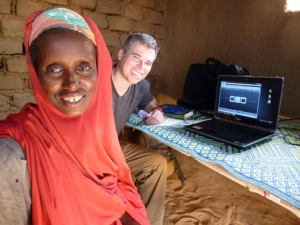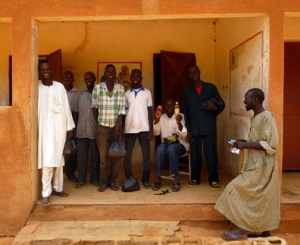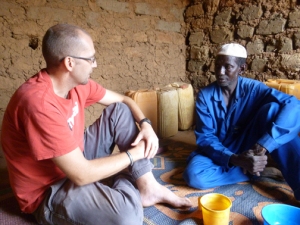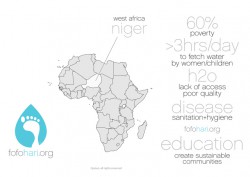WKU News
WKU graduate student continues water literacy project in Africa
- Thursday, August 14th, 2014
Oglesby’s fifth research trip to rural villages in region focuses on use of eye-tracking technology in image-driven water education
During July 2014, WKU Center for Water Resource Studies staff member and Department of Geography and Geology graduate student Jonathan (Joneo) Oglesby made his way back to Niger, West Africa, to continue his thesis research among the Songhai people.

A Fulani woman in the village of Kakassi shared that she was taught by WKU graduate student Jonathan Oglesby during an earlier research trip to West Africa.
This trip marked Oglesby’s fifth to the region and focused on the use of eye-tracking in the evaluation of image-driven water education, which utilizes cultural- and gender-appropriate images designed to foster visual storytelling.
“When you have a cultural group who, for the most part, can’t read or write, information is passed through conversations and storytelling. I worked hard to use simplistic imagery in an effort to improve comprehension and recall of key concepts,” Oglesby said.
Images developed for this research focus on water pollution, sanitation and hygiene protocols, and personal water-treatment techniques.
Oglesby carried Tobii eye-tracking equipment used in the eye-tracking laboratory of Dr. Leslie North, Geography and Geology faculty member, to 12 rural villages, conducting a total of 464 eye-tracking trials and nearly 24 hours of recorded audio interviews. Eye tracking uses specialized equipment to measure and record quantitatively where a person’s eyes are looking, the order in which they look at an image, and how long an observer gazes upon areas of interest.
The use of eye-tracking technology for this project allows for the collection of quantitative data about how West African culture groups view and interact with the newly developed water education materials. This is one of (and perhaps) the first studies of its kind to investigate effective visual learning design with eye-tracking in rural villages of Africa. Oglesby worked in bush maternity wards, medicinal depositories, and mud-brick homes during the research expedition. Nine culture groups were tested that included Songhai, Zerma, Hausa, Kutay, Gourmanche, Fulani, Kado, Mori and Tamachek.
“My research is gender specific, focusing on women, who are the primary water fetchers and users in Sub-Saharan Africa. The work has taken me to over 23 villages so far,” Oglesby said. “It’s impossible to do this without support from WKU, the Department of Geography and Geology, my advisor, Dr. Leslie North, and tremendous support from national partners within the region. Translation, logistics and ground support are critical for success and I am extremely grateful for all those who help me. Few have done more than Mark Phillips, who lives in Niger and has worked with me since the very beginning.”

A group of Zerma and Fulani men showed the contents of their care packages they received after conducting eye-tracking trials in the village of Bassi.
Care packages, valued at US $5, were given to each participant, and included ½ liter of cooking oil, 1.5 kilograms of rice, 10 bouillon cubes, 2 cans of tomato paste and 2 packages of pasta. “We wanted to give back to the people who took time out of their day to assist in this research,” Oglesby said. “We bought the care packages from a business man in the capital city who has a small side shop. I think it goes without saying, a little here goes a very long way.”
Each day, 33 children die from diarrhea caused by unsafe drinking water and improper sanitation in the West African country of Niger. More than 80 percent (14 million people) don’t have access to proper sanitation. Nearly 50 percent (8 million people) don’t have access to safe drinking water. Almost half of the country’s population lives in extreme poverty on less than US $1.25 per day. Seventy-one percent of the adult population (15 years and older) can’t read or write. By using science-driven water literacy visual communication techniques, Oglesby is striving not only to educate through the use of images, but also to contribute to the wider community about informal science education and visual learning.
“Science doesn’t always give you the answers you want. But that’s why you do it,” Oglesby said. “I believe we can overcome the hurdles of illiteracy and cultural barriers to educate hard-to-reach culture groups about water, sanitation and hygiene. By pushing the imagery as far as we can in our research methods, we are attempting to create a new way of approaching education. Visual communication will never be a panacea, but why not get as close as you can using all the tools and creative technologies available?”
At a mud brick home in the village of Kakassi, Oglesby recalled meeting a lady he had interacted with on an earlier research trip. “We were going through the interview portion of our eye-tracking trials when I asked the question: ‘Do you know of any way that the sun can purify your water?’ The lady responded, ‘Yes,’ almost immediately. I was quite taken aback, because routinely people would firmly answer ‘No, I’ve never heard of that’ when I inquired. I immediately asked, ‘How do you know this?’ She responded, ‘You showed me how the last time you were here and I’ve been doing it ever since.’ This type of positive reinforcement that the learning tools work and have longevity in the community, rather than being temporary fixes, is exactly what the goal of this project is all about.”
Beyond the research aspect of Oglesby’s trip, deep in the bush, outside of the village of Toure, a small community of families was equipped with the resources they needed to start their own solar disinfection system. “We had this idea where we would buy local materials in the market and set up a simple solar disinfection system for a small group of people and train them on how to use it. Then, periodically, Mark would check back in with them to see how it was performing.”

Mark Phillips translated Mounkaya’s thoughts and feelings about his water quality. Phillips, who lives in Niger, has been assisting WKU’s Jonathan Oglesby in his research project there.
The team spent a total of US $12 on materials that included 16 1.5 liter clear plastic bottles for $1.50, one funnel for $1, five bricks for $4, one 4’ x 4’ sheet of reflective metal for $3.50, and two 25-liter “Jerry Cans” for water fetching and storage for $2. By buying local materials, they helped five small businesses. But the ability to empower a group of individuals with education and materials to perform their own solar disinfection proved priceless.
“Seeing the look on the face of a man we taught how to treat his own water with the very images we’ve been using in our research was so exciting,” Oglesby said. “He immediately understood and taught it back to us. He was so thrilled that he now had the ability to treat his own water. He was empowered.”
“I feel so blessed and humbled to be a part of this research project,” Dr. North said. “Jonathan’s passion for water resources and the culture groups of Niger inspires those of us who know him to come to work every day and invest our time into doing good things for people. His research illustrates how thoughtful hard work and applied science can help make a meaningful and positive impact in the world. I fully believe he is touching the lives of those he is working with in the region through not only this research project, but also his personal humanitarian efforts. Through this research we hope to be able to contribute to the scientific community and humanitarian groups with the information they need continually to maximize the effectiveness of educational materials.”
 For information about this research project or eye-tracking, contact Jonathan Oglesby at jonathan.oglesby@wku.edu or Dr. Leslie North at leslie.north@wku.edu.
For information about this research project or eye-tracking, contact Jonathan Oglesby at jonathan.oglesby@wku.edu or Dr. Leslie North at leslie.north@wku.edu.
Oglesby also has created a non-profit organization called Fofo Hari to continue his work in the region even after the research portion is complete. Visit www.fofohari.org to learn more.
Some of the links on this page may require additional software to view.

